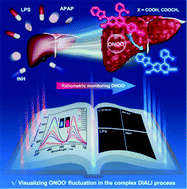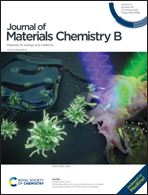A highly selective ratiometric molecular probe for imaging peroxynitrite during drug-induced acute liver injury†
Abstract
Drug-induced acute liver injury (DIALI) is a common liver disease, affecting a number of people worldwide with increasing morbidity each year. Thus, it is vital to develop new tools for intervention and diagnosis. Peroxynitrite (ONOO−), a highly reactive species, plays an important role in the DIALI process. Thus, in situ molecular imaging of endogenous ONOO− levels is considerably significant for detecting ONOO−. In this work, we present two destroyed-type ratiometric fluorescent probes, AHC and AHMC, for ONOO− detection by using a molecular hybridization strategy. The probe AHMC was developed by introducing the ester structure to AHC directly to enhance its membrane penetrability for living cell imaging. Probe AHC exhibited good analytical performance toward ONOO− compared to other reactive species, with a low detection limit (≈1.8 nM) and a strong ratiometric fluorescence response (134-fold). In cell imaging experiments, AHMC showed outstanding selectivity, favourable biocompatibility and mitochondria-targeting ability, which not only was used to detect endogenous and exogenous ONOO− changes, but also enabled noninvasive visualization of ONOO− generation in a different drug-induced DIALI model. We hope that these ratiometric probes can be useful chemical tools for the in-depth research of drug-induced acute hepatotoxicity.



 Please wait while we load your content...
Please wait while we load your content...